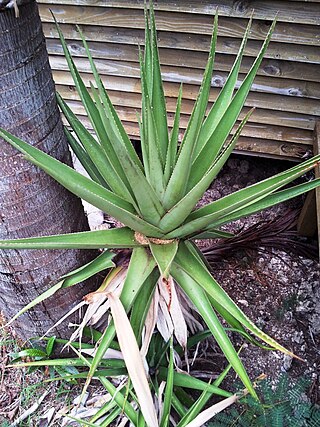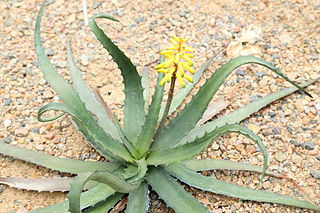
Aeacus was a mythological king of the island of Aegina in the Saronic Gulf. He was a son of Zeus and the nymph Aegina, and the father of the heroes Peleus and Telamon. According to legend, he was famous for his justice, and after he died he became one of the three judges in Hades alongside Minos and Rhadamanthos. In another story, he assisted Poseidon and Apollo in building the walls of Troy.

Aegina is one of the Saronic Islands of Greece in the Saronic Gulf, 27 km (17 mi) from Athens. Tradition derives the name from Aegina, the mother of the mythological hero Aeacus, who was born on the island and became its king.

Aphaia was a Greek goddess who was worshipped almost exclusively at a single sanctuary on the island of Aegina in the Saronic Gulf.

The prothonotary warbler is a small songbird of the New World warbler family. It is named for its plumage which resembles the yellow robes once worn by papal clerks in the Roman Catholic Church.

Aegina was a figure of Greek mythology, the nymph of the island that bears her name, Aegina, lying in the Saronic Gulf between Attica and the Peloponnesos. The archaic Temple of Aphaea, the "Invisible Goddess", on the island was later subsumed by the cult of Athena. Aphaia (Ἀφαῖα) may be read as an attribute of Aegina that provides an epithet, or as a doublet of the goddess.

The Temple of Aphaia or Afea is an Ancient Greek temple located within a sanctuary complex dedicated to the goddess Aphaia on the island of Aegina, which lies in the Saronic Gulf. Formerly known as the Temple of Jupiter Panhellenius, the Doric temple is now recognized as having been dedicated to the mother-goddess Aphaia. It was a favourite of Neoclassical and Romantic artists such as J. M. W. Turner. It stands on a c. 160 m peak on the eastern side of the island approximately 13 km east by road from the main port.

Amphioctopus is a genus of octopuses comprising around 16 species.

Cydippida is an order of comb jellies. They are distinguished from other comb jellies by their spherical or oval bodies, and the fact their tentacles are branched, and can be retracted into pouches on either side of the pharynx. The order is not monophyletic, that is, more than one common ancestor is believed to exist.
In Greek mythology, Nerites was a minor sea deity, the son of "Old Man of the Sea" Nereus and the Oceanid Doris and brother of the fifty Nereids. He was described as a young boy of stunning beauty. According to Aelian, although Nerites was never mentioned by epic poets such as Homer and Hesiod he was a common figure in the mariners' folklore nevertheless.
Pseudoalteromonas citrea is a yellow-pigmented marine bacterium that is antibiotic-producing and was isolated from Mediterranean waters off Nice. Originally named Alteromonas citrea, nearly two decades later it was reclassified as part of the Genus Pseudoalteromonas.

Church of St. Nicholas in Jagodnjak is Serbian Orthodox church in eastern Croatia. The church was built in 1725. Church gain attention in 2012 when local believer claimed apparation of Nectarios of Aegina in her dream. In 2013 special place in church with saint's icon was built, and pilgrimage to Aegina was organized. In 2015 Eparchy of Osječko polje and Baranja initiated building of smaller church dedicated to Nectarios of Aegina.
Micromonospora citrea is an endophytic actinomycete. It produces citreamicins, several types of antibacterial antibiotics.

Aloe sect. Lomatophyllum is a taxonomic section within the genus Aloe, comprising between 12 and 18 closely related species of Aloe from Madagascar and the Mascareigne islands.

Aegina citrea is a genus of hydrozoans in the family Aeginidae.
Oleiagrimonas citrea is a Gram-negative, rod-shaped and aerobic bacterium from the genus of Oleiagrimonas which has been isolated from tidal flat sediments from the Suncheon Bay in Korea.

Aloe citrea, is a species of Aloe found in South Eastern Madagascar.
Distichochlamys citrea is a species of flowering plant in the ginger family. It was first described by M.F.Newman.
Marinirhabdus citrea is a Gram-negative, aerobic, rod-shaped and non-motile bacterium from the genus of Marinirhabdus which has been isolated from seaweed from Yeonggwang County.
Spongiivirga is a Gram-negative, strictly aerobic, rod-shaped and non-motile genus of bacteria from the family of Flavobacteriaceae with one known species. Spongiivirga citrea has been isolated from the marine sponge Tethya sp..
Cyanea citrea is a species of true jellyfish in the family Cyaneidae. It has been found in waters off the coasts of Japan and Russia. The generic name, Cyanea, is derived from the Latin cyaneus, meaning "deep or dark blue in color". The specific epithet, citrea, is derived from the Latin citreus, meaning "citrus", likely in reference to the species' orange color.












